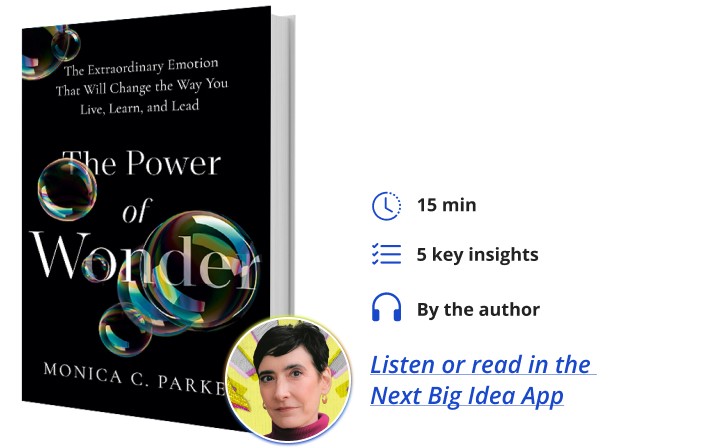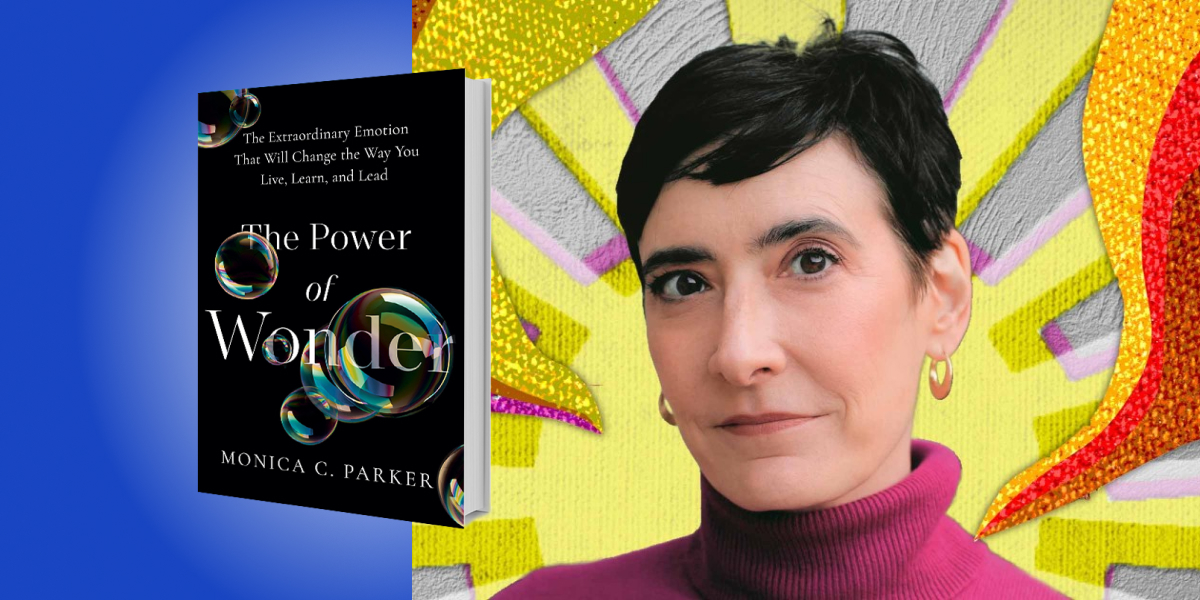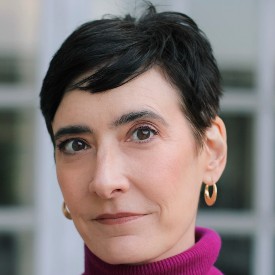Monica Parker has a Master’s in Sustainable Behavior and is considered an authority on the future of work. She is also the founder of HATCH, a global human analytics and change consultancy.
Below, Monica shares 5 key insights from her new book, The Power of Wonder: The Extraordinary Emotion that Will Change the Way You Live, Learn and Lead. Listen to the audio version—read by Monica herself—in the Next Big Idea App.

1. Wonder is universal and ineffable.
Universal and innate, like a type of emotional DNA, wonder spirals its way through our shared human experience, imprinting itself on our lives. Art, music, religion, politics, science, nature, love, fear, birth, death; each of the myriad experiences that compress to form the bedrock of human life has a golden vein of wonder running through it.
But what is it? Part of the challenge in answering that question is that wonder is often ineffable, it defies language. Even though we have all experienced wonder, we frequently don’t have the words to express the magnitude or the meaning of wonder.
There may be few modern pieces of literature that better describe the ineffability of wonder than Carl Sagan’s book and subsequent film Contact. Most of you are probably familiar with it, but it’s the story of an agnostic scientist named Ellie, whose beliefs are challenged by a trip through a wormhole. During the wonder-filled transcendent climax of the film, Ellie is struck by the ineffability of the experience, exclaiming, “No words to describe it. Poetry! They should have sent a poet.” That line hits me every time! A perfect expression of the universal, undeniable, and yet ineffable power of wonder.
Wonder’s meaning is also hard to pin down because it’s something of a shapeshifter. Wonder is both a verb and a noun. A process and an outcome. Five interlinking elements comprise the wonder cycle: “watch”, “wander”, “whittle”, “wow”, and “whoa” (or the psychological terms openness to experience, curiosity, absorption, and the two phases of awe.) Each element has its own benefit and beauty, offering an opportunity for discovery about ourselves and how we see and move through the world.
“Watching” is about being present and open and “wandering” is an inquisitive cognitive stroll that allows curiosity to flourish. Then there is the absorption of “whittle”, the paring down of the mental aperture from broad to focused. Whittle is when we are most prepared for the expectation violation of the “wow” moment, where our anticipation of what’s next is challenged such that our mind struggles to make sense of it. Then comes the final stage, the “whoa”, where our psyche acclimates to this new stimulus, and that experience changes us, sometimes forever.
2. Happiness is overrated. Wonder is better for us and more achievable.
Throughout modern history, and with little contesting, happiness has been seen as the end goal and just reward for a life well-lived. It’s an unfortunate irony, then, that in a world obsessed with happiness, we’re actually so lousy at finding it.
Here’s the problem, as humans, we “miswant” a lot of things that we have been conditioned to believe will make us happier than they actually do. Much of what we’re conditioned to believe will make us happy is based on consumerism, and hence are hedonic pursuits, or pursuits of pleasure—things like a new pair of shoes or a strong cocktail. In studies, consistently, even the more meaningful type of happiness—eudemonic happiness—still does not create the quantum of benefits as wonder does.
“During times of pandemic, war, social unrest, or just life, it’s not natural to feel happy all the time, but we can still feel a sense of wonder.”
Part of the reason wonder is more beneficial is what’s known as the valance of an emotion. Happiness, by its nature, is always positively “valanced”, but that is not a steady state. It’s simply not realistic to always be happy, nor is it particularly good for us. During times of pandemic, war, social unrest, or just life, it’s not natural to feel happy all the time, but we can still feel a sense of wonder. This is because wonder is a mixed emotion, where we experience both positive and negative emotional tones, even at the same time. Mixed emotions are good for us because embracing negative emotions adds to the richness of our human experience. They broaden our emotional vocabulary, and embracing both positive and negative emotions at the same time is a powerful coping mechanism that aids in resilience.
For example, in one study of bereaved spouses, widows and widowers who recalled both positive and negative elements of their deceased spouse were better able to manage their grief.
Wonder finds us in all shades of light and dark. In grief and pain. In joy and laughter. In bittersweet longing and transition and loss. Wonder embraces that beautiful, messy complexity of life in a way happiness doesn’t. That uncomfortable balancing coexistence feels more true to me than a manufactured cajoling towards happiness. It’s great to be happy, but it’s even better to be in wonder.
3. Newness gets noticed, but only if you’re not moving too fast.
Let’s imagine a scene: you’re racing out the door, frazzled and dreadfully late to a meeting. As you leave the house, you flick the light switch off, and nothing happens; the lights stay on. You might be a bit surprised, but it’s only a small difference from what you expect, so after a few seconds, you would likely go on your way, making a note to call a repair person.
But what if every time you flicked the light switch on and off, your cat disappeared and reappeared? That would be freak-out inducing, not only going against what you know about light switches but also what you know about physics—and cats. Such a phenomenon would be a massive change to your expectation, as the disappearing and reappearing cat would be impossible to ignore; this level of change would be wonder-inducing.
Contrast is a dominant force in how we observe the world. In many ways, contrast, or change, is all that we see. For example, in our visual field, the way we notice colors, light, and depth are all built around contrasts. The same goes for our mental field, which is driven by how we collect and process stimuli.
Our brain picks up about eleven million bits of stimuli per second, but we can’t possibly notice everything we take in. To help us make sense of what would otherwise be a debilitating cacophony of information, it sorts these stimuli and builds easy patterns for us to follow, registering what is different enough for us to notice and what is similar enough that it can be ignored. This is a very efficient way of operating but creates a lot of mental shortcuts that we tend to lean on quite heavily when we’re too rushed. Those shortcuts often create a detour around wonder.
“Contrast is a dominant force in how we observe the world.”
Now, going back to our light switch example, what if on your way out the door, you were in such a rush that you didn’t notice anything? The light switch is bedeviled, Mr. Bigglesworth vanishes beyond the veil, and you simply missed the whole freaking thing because your brain was completely focused elsewhere.
When we fail to be present in the moment, we close ourselves off from opportunities to become curious and absorbed, and hence may miss glimpses of wonder. Slowing down, and practicing slow thought activities, like meditation, or narrative journaling, helps us notice the differences around us and opens us up to the wonder in our everyday life.
4. It’s more than a moment, it’s a mindset.
It’s easy to focus too heavily on finding that rare, fleeting moment that leads to the big “wow” and “whoa” experience, but wonder is more than a moment, it’s a mindset.
What does that mean? Imagine one of those Magic Eye posters from the 1990s. Do you remember those? They were these digitally generated posters that looked like a staticky pattern of fractals. You weren’t trying to see that patterned image, you were trying to see another image hidden within the piece. To view this magic image, one would stare at the poster head tilted, maybe squinting, until, “whoa!” The brain would sort through the noise of the patterns, and the hidden image would suddenly jump out in 3D. The more experience a person had looking at various Magic Eye posters, the more proficient they became. This reminds me that wonder is always there. Sometimes, we just need to quiet the noise and cultivate the mindset to see it.
What is a wonder mindset? People with a wonder mindset are present, open, mentally nimble, and curious in a deep and exploratory way. They are moved by music and can get lost in vivid thought. They are comfortable with the unknown and unknowing, walking toward questions rather than away. They seek and embrace opportunities to contribute to and connect with others. While an external event (an aria, the Grand Canyon, a religious ritual) might be the springboard, it is our own mind that actually embodies wonder. A wonder mindset is less about the synergist and more about our way of seeing. The wonder catalyst knocks on the door; a wonder mindset gives us the keys to open it.
5. There is more.
We are often very quick to shut down our uncertainty. Rather than sitting in the unknown, we rush to define an experience so we can codify it, put it in a box, and file it away. We often don’t like to marinate in the gray, instead, we seek the comfort of black and white. That just further polarizes our viewpoints and leads us away from a wonder mind-set. We know so little of the world, so little of ourselves, that what we see and know and experience today simply can’t be all there is.
“Wonder straddles the gateway between our normal waking consciousness and the realm beyond.”
For millennia we viewed stars with our naked eye, but before the first telescope was invented in the 1600s, the true vastness of the cosmos was more a matter of imagination than science. Prior to the microscope, we couldn’t even conceive of the mysterious quantum dance that resides within all matter, but it existed nonetheless. I believe wonder is our “psychescope”. It’s a device that allows us to peer inside our consciousness and see beyond our current conception of ourselves, no longer constrained by just mystery and our imagination.
Wonder straddles the gateway between our normal waking consciousness and the realm beyond. There exists a magic crackle, a sacred thrum, found at the threshold between two states. Whether brought about by meditation, psychedelics, or just the most excruciatingly beautiful sunset imaginable, these moments are our indication that we are at the cusp of more.
These moments are the messenger that this chaotic, insane, baffling, lush, enchanting, intricate, tender, fragile earthly plane hurtling through space is not all there is. When we become attuned to more, when we cross over the threshold and walk through the door of perception, the magnitude of this illusory world shrinks in relation to the wonder we find on the other side.
If we created a world where we met each other in wonder, with non-judgmental openness, with empathetic curiosity, with our minds willing to be filled and changed, with the focus and attention that reflect our gratitude for that moment, in awe of the very nature of existence, we can discover the true power of wonder together.
To listen to the audio version read by author Monica Parker, download the Next Big Idea App today:





























